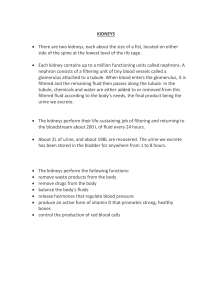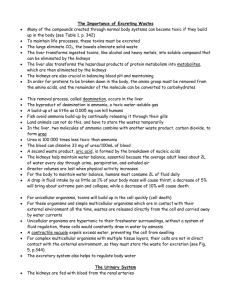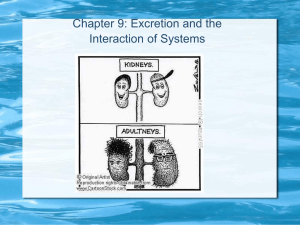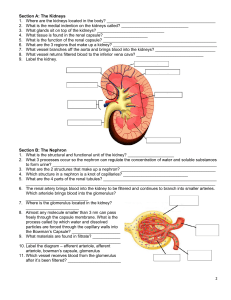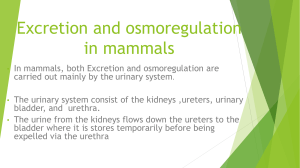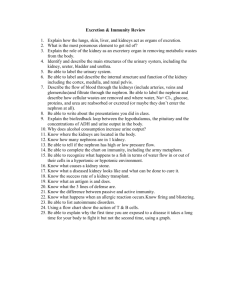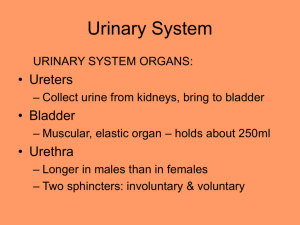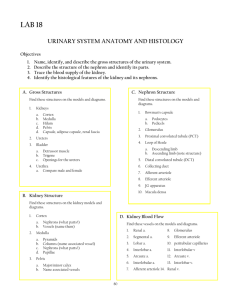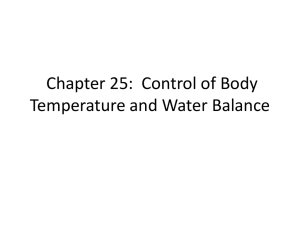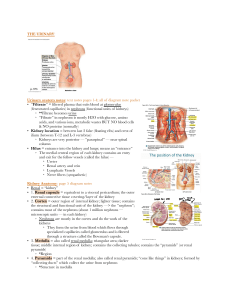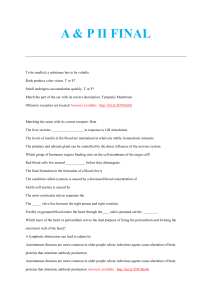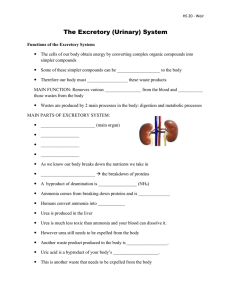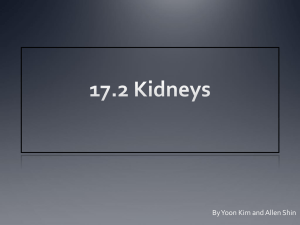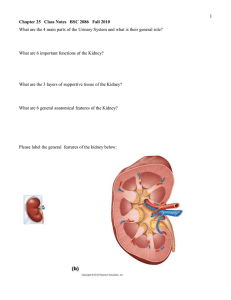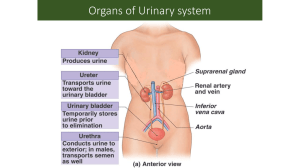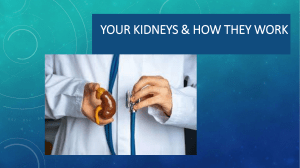1. Description and Function
advertisement
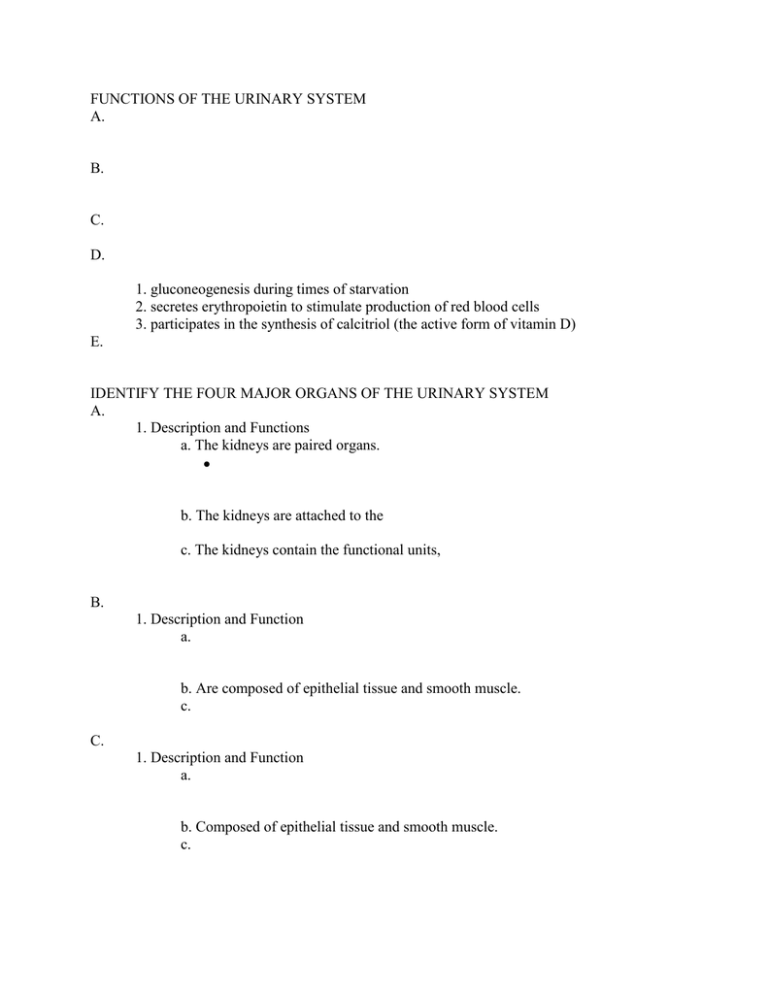
FUNCTIONS OF THE URINARY SYSTEM A. B. C. D. 1. gluconeogenesis during times of starvation 2. secretes erythropoietin to stimulate production of red blood cells 3. participates in the synthesis of calcitriol (the active form of vitamin D) E. IDENTIFY THE FOUR MAJOR ORGANS OF THE URINARY SYSTEM A. 1. Description and Functions a. The kidneys are paired organs. b. The kidneys are attached to the c. The kidneys contain the functional units, B. 1. Description and Function a. b. Are composed of epithelial tissue and smooth muscle. c. C. 1. Description and Function a. b. Composed of epithelial tissue and smooth muscle. c. D. 1. Description and Function a. b. Composed of epithelial tissue and smooth muscle. IDENTIFY THE GROSS ANATOMY OF THE KIDNEYS A. Description: The kidneys are paired, reddish-colored organs that resemble a kidney bean. They are located just above the waist between the parietal peritoneum and the posterior wall of the abdomen and are said to be retroperitoneal. They measure about 10 -12 cm (4 to 5 inches) long, 5 to 7.5 cm (2 to 3 inches) wide, and 2.5 cm (1 inch) thick and are roughly the size of a fist. The concave border faces medially while the convex surface is positioned laterally. The hilus is the notch near the center of the concave medial border through which the ureter leaves the kidney, and blood and lymphatic vessels and nerves enter and leave the kidney. The renal sinus is the cavity within the kidney that originates at the hilus. B. Internal Anatomy of the Kidney: 1. 2. 3. 4. IDENTIFY THE MICROSCOPIC STRUCTURE OF THE NEPHRONS The nephrons are the functional units of the kidneys. They filter the blood removing waste products and forming urine. The nephrons are located in both the cortical and medullary area of the kidney. A. Structures of the Nephron 1. . a. b. Glomerulus is a tuft or knot of capillaries where filtration occurs i. ii. iii. . iv. 2. a. b. i. descending limb ii. nephron loop iii. ascending limb c. 3. a. Blood vessels (capillaries) surrounding the renal tubules. b. Involved with reabsorption of electrolytes and other necessary minerals from the filtrate as it passes through the renal tubule. c. Also play a role in secretion as substances are removed from the blood and secreted back into the tubule for excretion as urine. 4. Juxtaglomerular Apparatus a. Located where the distal convoluted tubule touches the afferent arterioles. b. Plays an important role in regulating rate of urine formation and regulating blood pressure. B. Function of the Nephrons 1. The nephrons are responsible for removing wastes from the blood and regulating blood fluid and electrolyte composition. a. Controls blood concentration and volume by removing selected amounts of water and solutes. b. Regulates blood pH. c. Removes toxic wastes from the blood. d. The fluid and solutes removed from the blood by the nephrons are collectively called urine. e. The entire volume of blood in the body is filtered by the kidneys approximately 60 times each day. Filters about 180 liters (45 gallons) of fluid a day. 99% of fluid that passes through the kidneys is returned to the blood NAME AND DESCRIBE THE THREE BASIC PHYSIOLOGICAL PROCESSES IN URINE FORMATION There are three process involved in urine formation: A. 1. Forcing of fluids and dissolved substances from the blood through a membrane by pressure from the glomerulus to the glomerular (Bowman's) capsule. 2. Occurs in the renal corpuscle of the kidney. Water and dissolved substances are forced out of the blood at the glomerulus into the glomerular capsule. 3. Large molecules, such as plasma proteins and red blood cells, are not filtered out of the blood. B. 1. Occurs in the renal tubules which are composed of: a. proximal convoluted tubule b. loop of Henle (nephron loop) c. distal convoluted tubule 2. As the filtrate passes through the renal tubules about 99% of the filtrate is reabsorbed by the body. a. Only 1% of the filtrate actually leaves the body as urine (1.5 liters a day). b. Materials commonly reabsorbed include: water, glucose, amino acids,urea, and ions such as Na+, K+, Ca+2, Cl-, HCO3-, and HPO4-2 . c . Allows the body to retain most of its nutrients. C. 1. Essentially the opposite of reabsorption. 2. Secreted substances include: K+, H+, ammonia, creatine, and the drugs penicillin and para-amino hippuric acid 3. Certain materials can be removed from the body. 4. Helps control the body's blood pH. http://bradyfonnesbeck.wikispaces.com/file/view/MaP+Unit+11+Lecture+Notes+11-12.pdf
